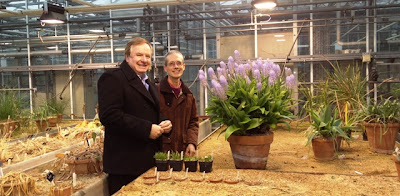This giant squill is simply delightful Madeira
No I haven't been to Madeira. But according to Greg Redwood, one of my colleagues here at Kew, I should go there rather than to (mainland) Portugal. This was in response to me listing the places in Europe Lynda and I had hoped to visit while on this side of the world.
Oh, well. Next time. For now though I have the Madeirenese (I'm torn here between Madeiranese and Madeirenese - if only I'd studied Latin at school) flora to enjoy. And isn't that the great thing about a botanic garden: you can visit the plant world without leaving home.
Even better of course, discover the flora then the country. But back to my featured plant from Madeira, Scilla madeirensis, the Giant Madeiran Squill. It's one of very few flowers out at the moment. Besides viburnum and mahonia you have to look hard for your floral delights in December.
I discovered the Giant Madeiran Squill last weekend, when walking through Kew Gardens with the Ross family from Sydney (Graham, Sandra, Kent and Kata ; that's Graham and me in one of the back-of-house nurseries at Kew; the rest of these pictures are from the Davies Alpine House).
Kew received it's first specimen of the Giant Madeiran Quill in 1976. Richard Wilford, Head of Hardy Display at Kew Gardens recalls this in his 2010 blog post, noting that the bulbs have to stay above ground to stop them rotting. This means we get to enjoy the bold red onion like textures and colours of the bulb, as well as the delicately lavender blue flowers peppered with brownish purple stamens as they open.
Scilla is in the hyacinth family (Hyacinthaceae), a group of plants that does seem to enjoy doing things in winter. Here are a few other members of the family from the other end of Africa, out in flower this week in Kew Gardens' Alpine House: Massonia pustulata, Whiteheadia bifolia (2 pictures) and Polyxena corymbosa.
So I've experienced a little of the flora of Africa and it's nearby islands this week. As you'd expect, the flora of Madeira has plenty of links to that of mainland Africa, as have Spain's Canary Islands which we visited last winter. I'll finish with a collage of wildflowers from Madeira, copied from Wiki Commons, where you might be able to spot a few more African links.










Comments